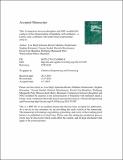Files in this item
Comparison between phosphine and NHC-modified Pd catalysts in the telomerization of butadiene with methanol – a kinetic study combined with model-based experimental analysis
Item metadata
| dc.contributor.author | Hopf, Lisa | |
| dc.contributor.author | Recker, Sebastian | |
| dc.contributor.author | Niedermaier, Matthias | |
| dc.contributor.author | Kiermaier, Stephan | |
| dc.contributor.author | Strobel, Vinzent | |
| dc.contributor.author | Maschmeyer, Dietrich | |
| dc.contributor.author | Cole-Hamilton, David | |
| dc.contributor.author | Marquardt, Wolfgang | |
| dc.contributor.author | Wasserscheid, Peter | |
| dc.contributor.author | Haumann, Marco | |
| dc.date.accessioned | 2016-08-11T23:33:03Z | |
| dc.date.available | 2016-08-11T23:33:03Z | |
| dc.date.issued | 2015 | |
| dc.identifier | 209148608 | |
| dc.identifier | 0d1a8ca8-c28a-4e38-9dc9-56381b097560 | |
| dc.identifier | 84979222066 | |
| dc.identifier.citation | Hopf , L , Recker , S , Niedermaier , M , Kiermaier , S , Strobel , V , Maschmeyer , D , Cole-Hamilton , D , Marquardt , W , Wasserscheid , P & Haumann , M 2015 , ' Comparison between phosphine and NHC-modified Pd catalysts in the telomerization of butadiene with methanol – a kinetic study combined with model-based experimental analysis ' , Chemical Engineering and Processing: Process Intensification , vol. In press . https://doi.org/10.1016/j.cep.2015.07.007 | en |
| dc.identifier.issn | 0255-2701 | |
| dc.identifier.other | RIS: urn:FDCB97B2B2680ACB9B8562E9C8F55964 | |
| dc.identifier.uri | https://hdl.handle.net/10023/9289 | |
| dc.description | The authors thank the European Community within its project SYNFLOW (FP7; grant agreement n8 NMP2-LA-2010-246461) for financial support. | en |
| dc.description.abstract | The telomerization of butadiene with methanol was investigated in the presence of different palladium catalysts modified either with triphenylphosphine (TPP) or 1,3-dimesityl-imidazol-2-ylidene (IMes) ligand. When pure butadiene was used as substrate, a moderate selectivity for the Pd-TPP catalyst toward the desired product 1-methoxy-2,7-octadiene (1-Mode) of around 87 % was obtained, while the IMes carbene ligand almost exclusively formed 1-Mode with 97.5 % selectivity. The selectivity remained unchanged when the pure butadiene feed was replaced by synthetic crack-C4 (sCC4), a technical feed of 45 mol% butadiene and 55 mol% inerts (butenes and butanes). The TPP-modified catalyst showed a lower reaction rate, which was attributed to the expected dilution effect caused by the inerts. Surprisingly, the IMes-modified catalyst showed a higher rate with sCC4 compared to the pure feed. By means of a model-based experimental analysis, kinetic rate equations could be derived. The kinetic modeling supports the assumption that the two catalyst systems follow different kinetic rate equations. For the Pd-TPP catalyst, the reaction kinetics were related to the Jolly mechanism. In contrast, the Jolly mechanism had to be adapted for the Pd-IMes catalyst as the impact of the base seems to differ strongly from that for the Pd-TPP catalyst. The Pd-IMes system was found to be zero order in butadiene at moderate to high butadiene concentrations and first order in base while the nucleophilicity of the base is influenced by the methanol amount resulting in a negative reaction order for methanol. | |
| dc.format.extent | 257180 | |
| dc.language.iso | eng | |
| dc.relation.ispartof | Chemical Engineering and Processing: Process Intensification | en |
| dc.rights | Copyright © 2015 Published by Elsevier B.V. This work is made available online in accordance with the publisher’s policies. This is the author created, accepted version manuscript following peer review and may differ slightly from the final published version. The final published version of this work is available at https://dx.doi.org/10.1016/j.cep.2015.07.007 | en |
| dc.subject | Telomerization | en |
| dc.subject | NHC ligand | en |
| dc.subject | TPP ligand | en |
| dc.subject | Palladium | en |
| dc.subject | Reaction kinetics | en |
| dc.subject | Model-based kinetic analysis | en |
| dc.subject | QD Chemistry | en |
| dc.subject | NDAS | en |
| dc.subject.lcc | QD | en |
| dc.title | Comparison between phosphine and NHC-modified Pd catalysts in the telomerization of butadiene with methanol – a kinetic study combined with model-based experimental analysis | en |
| dc.type | Journal article | en |
| dc.contributor.sponsor | European Commission | en |
| dc.contributor.institution | University of St Andrews.School of Chemistry | en |
| dc.identifier.doi | 10.1016/j.cep.2015.07.007 | |
| dc.description.status | Peer reviewed | en |
| dc.date.embargoedUntil | 2016-08-11 | |
| dc.identifier.grantnumber | 246461 | en |
This item appears in the following Collection(s)
Items in the St Andrews Research Repository are protected by copyright, with all rights reserved, unless otherwise indicated.

